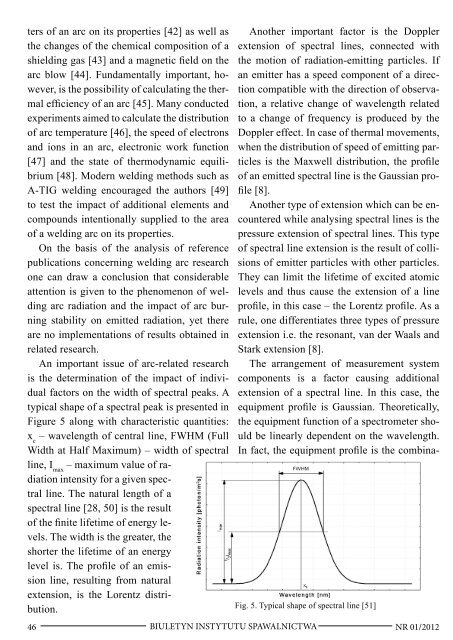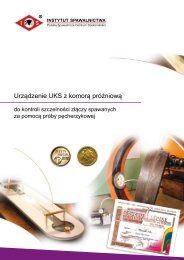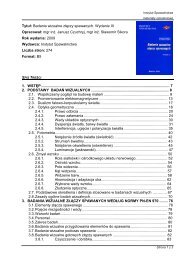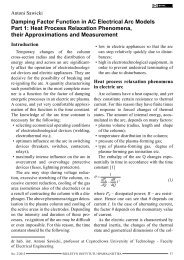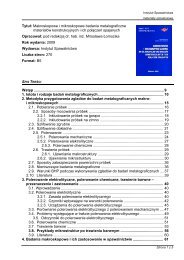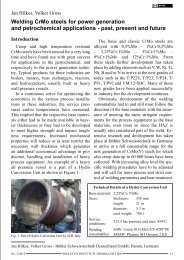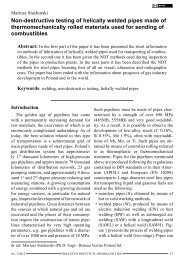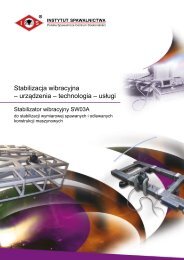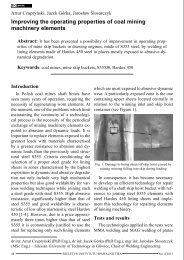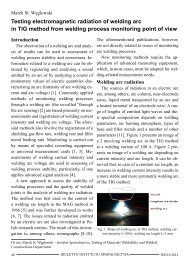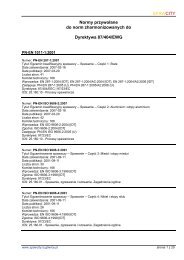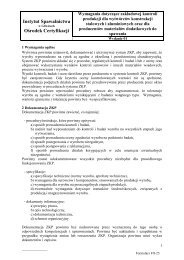Biuletyn Instytutu Spawalnictwa No. 01/2012
Biuletyn Instytutu Spawalnictwa No. 01/2012
Biuletyn Instytutu Spawalnictwa No. 01/2012
Create successful ePaper yourself
Turn your PDF publications into a flip-book with our unique Google optimized e-Paper software.
ters of an arc on its properties [42] as well as<br />
the changes of the chemical composition of a<br />
shielding gas [43] and a magnetic field on the<br />
arc blow [44]. Fundamentally important, however,<br />
is the possibility of calculating the thermal<br />
efficiency of an arc [45]. Many conducted<br />
experiments aimed to calculate the distribution<br />
of arc temperature [46], the speed of electrons<br />
and ions in an arc, electronic work function<br />
[47] and the state of thermodynamic equilibrium<br />
[48]. Modern welding methods such as<br />
A-TIG welding encouraged the authors [49]<br />
to test the impact of additional elements and<br />
compounds intentionally supplied to the area<br />
of a welding arc on its properties.<br />
On the basis of the analysis of reference<br />
publications concerning welding arc research<br />
one can draw a conclusion that considerable<br />
attention is given to the phenomenon of welding<br />
arc radiation and the impact of arc burning<br />
stability on emitted radiation, yet there<br />
are no implementations of results obtained in<br />
related research.<br />
An important issue of arc-related research<br />
is the determination of the impact of individual<br />
factors on the width of spectral peaks. A<br />
typical shape of a spectral peak is presented in<br />
Figure 5 along with characteristic quantities:<br />
x c<br />
– wavelength of central line, FWHM (Full<br />
Width at Half Maximum) – width of spectral<br />
line, I max<br />
– maximum value of radiation<br />
intensity for a given spectral<br />
line. The natural length of a<br />
spectral line [28, 50] is the result<br />
of the finite lifetime of energy levels.<br />
The width is the greater, the<br />
shorter the lifetime of an energy<br />
level is. The profile of an emission<br />
line, resulting from natural<br />
extension, is the Lorentz distribution.<br />
46 BIULETYN INSTYTUTU SPAWALNICTWA<br />
Another important factor is the Doppler<br />
extension of spectral lines, connected with<br />
the motion of radiation-emitting particles. If<br />
an emitter has a speed component of a direction<br />
compatible with the direction of observation,<br />
a relative change of wavelength related<br />
to a change of frequency is produced by the<br />
Doppler effect. In case of thermal movements,<br />
when the distribution of speed of emitting particles<br />
is the Maxwell distribution, the profile<br />
of an emitted spectral line is the Gaussian profile<br />
[8].<br />
Another type of extension which can be encountered<br />
while analysing spectral lines is the<br />
pressure extension of spectral lines. This type<br />
of spectral line extension is the result of collisions<br />
of emitter particles with other particles.<br />
They can limit the lifetime of excited atomic<br />
levels and thus cause the extension of a line<br />
profile, in this case – the Lorentz profile. As a<br />
rule, one differentiates three types of pressure<br />
extension i.e. the resonant, van der Waals and<br />
Stark extension [8].<br />
The arrangement of measurement system<br />
components is a factor causing additional<br />
extension of a spectral line. In this case, the<br />
equipment profile is Gaussian. Theoretically,<br />
the equipment function of a spectrometer should<br />
be linearly dependent on the wavelength.<br />
In fact, the equipment profile is the combina-<br />
Fig. 5. Typical shape of spectral line [51]<br />
NR <strong>01</strong>/2<strong>01</strong>2


